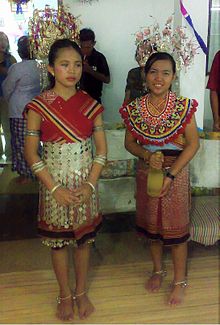Iban History
The Ibans comprise the largest percentage (almost 30%) of Sarawak's population. Iban is native to Sarawak and Sarawak has the highest number of Ibans in Borneo. Formerly reputed to be the most formidable headhunters on the island of Borneo, the Ibans of today are a generous, hospitable and placid people. |
| iban_worrior |
Because of their history as farmers, pirates and fishermen, Ibans
were conventionally referred to as the "Sea Dayaks". The early Iban
settlers migrated from Kalimantan, the Indonesian part of Borneo south
of Sarawak, via the Kapuas River. They crossed over the Kelingkang range
and set up home in the river valleys of Batang Ai, the Skrang River,
Saribas, and the Rajang River. The Iban dwell in longhouses, stilted structures with a large number of rooms housing a whole community of families
The
Iban trace their origins to the Kapuas Lake region of Kalimantan. With a
growing population, creating pressures on limited amounts of productive
land, the Iban fought members of other tribes aggressively, practicing
headhunting and slavery. Enslavement of captives contributed to the
necessity to move into new areas.
 |
| iban_attire |
By the middle of the nineteenth century, they were well established in the First and Second Divisions, and a few had pioneered the vast Rejang River valley. Reacting to the establishment of the Brooke Raj in Sarawak in 1841, thousands of Iban migrated to the middle and upper regions of the Rejang, and by the last quarter of the century had entered all remaining divisions.
The most dramatic changes in the past three decades have been abandonment of longhouses and permanent settlement in Sarawak’s towns and cities. Iban have lived near other ethnic groups with whom they have interacted. The most important of these societies have been the Malays, Chinese, Kayan and, during the Brooke Raj and the period of British colonialism, Europeans. The dynamic relations between Iban and these societies have produced profound changes in Iban society and culture.
The Ibans were a strong and successful warring tribe in Borneo. They speak the Iban language.An Iban longhouse may still display head trophies or antu pala. These suspended heads mark tribal victories and were a source of honour. The Dayak Iban ceased practising headhunting in the 1930s.
 |
| Rentap |
Although Ibans generally speak a dialect which is mutually intelligible, they can be divided into different branches which are named after the geographical areas where they reside.
- Majority of Ibans who live around the Lundu and Samarahan region are called Sebuyaus.
- Ibans who settled in areas in Serian district (places like Kampung Lebor, Kampung Tanah Mawang & others) are called Remuns. They may be the earliest Iban group to migrate to Sarawak.
- Ibans who originated from Sri Aman area are called Balaus.
- Ibans who come fromBetong, Saratok & parts of Sarikei are called Saribas.
- The Lubok Antu Ibans are classed by anthropologists as Ulu Ai Ibans.
- Ibans from Undup are called Undup Ibans. Their dialect is somewhat a cross between the Ulu Ai dialect & the Balau dialect.
- Ibans living in areas from Sarikei to Miri are called Rajang Ibans. They are the majority group of the Iban people. They can be found along the Rajang River, Sibu, Kapit, Belaga, Kanowit, Song, Sarikei, Bintangor, Bintulu and Miri. Their dialect is somewhat similar to the Ulu Ai dialect.